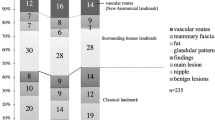Abstract
Purpose
The purpose of this study was preoperatively to diagnose the intraductal component, which is indispensable in planning for breast conservation therapy, and also to minimize local recurrence. This study investigated the efficacy of ultrasound (US) in the detection of intraductal component in comparison with magnetic resonance imaging (MRI) and histopathological findings.
Patients and Methods
In 47 patients with invasive breast cancer, US features of the intraductal component were classified as (a) solid ductal dilatation radiating from the tumor, (b) presence of satellite lesion in the same segment without ductal dilatation, and (c) ductal dilatation between the main tumor and satellite lesion. MRI depicted intraductal extension as the most enhanced area during the first or second phase of the dynamic study. Other criteria for the detection of the intraductal component by MRI were as follows: (a) a satellite lesion around the main tumor, (b) bridging enhancement between the main tumor and satellite lesions. The extent of the intraductal component was measured and classified as mimimal (0–5 mm), moderate (6–15 mm) or wide (>15 mm).
Results
In 28 of 47 (60.0%) patients, a wide intraductal component of more than 15 mm was proved histopathologically. Of 28 patients, US and MRI could accurately detect wide intraductal components in 16 patients and 14 patients, respectively. Sensitivity, specificity, and accuracy were 57.1%, 84.2%, and 68.1% respectively for US and 50.0%, 89.5% and 65.9% for MRI, respectively. When both US and MRI results were combined, sensitivity, specificity, and accuracy were 75.0%, 84.2%, and 78.7%.
Conclusion
Current US examination depicted the intraductal component of breast cancer more accurately than MRI. Further, our study suggests that the use of both US and MRI together is complementary and offers more advantage than US alone.
Similar content being viewed by others
References
Stavros AT, Thickman D, Rapp CL, Dennis MA, Parker SH, Sisney GA. Solid breast nodules: use of sonography to distinguish between benign and malignant lesions.Radiology, 196: 123–134, 1995.
Gordon PB, Goldenberg SL. Malignant breast masses detected only by ultrasound. A retrospective review.Cancer, 76: 626–630, 1995.
Kaplan SS. Clinical utility of bilateral whole-breast US in the evaluation of women with dense breast tissue.Radiology, 221: 641–649, 2001.
Tsunoda HS, Ueno E, Tohno E, Akisada M. Echogram of ductal spreading of breast carcinoma,Jpn J Med. Ultrasonics, 17: 44–48, 1990. (in Jpse.)
Satake H, Shimamoto K, Sawaki A,et al. Role of ultrasonography in the detection of intraductal spread of breast cancer: correlation with pathologic findings, mammography and MR imaging.Eur Radiol, 10: 1726–1732, 2000.
Gilles R, Guinebretiere JM, Lucidarme O,et al. Nonpalpable breast tumors: diagnosis with contrast-enhanced subtraction dynamic MR imaging.Radiology, 191: 625–631, 1994.
Bone B, Aspelin P, Bronge L, Isberg B, Perbeck L, Veress B. Sensitivity and specificity of MR mammography with histopathological correlation in 250 breasts.Acta Radiol, 37: 208–213, 1996.
Hata T, Takahashi H, Watanabe K,et al. Magnetic resonance imaging for preoperative evaluation of breast cancer: a comparative study with mammography and ultrasonography.J Am Coll Surg, 198: 190–197, 2004.
Holland R, Connolly JL, Gelman R,et al. The presence of an extensive intraductal component following a limited excision correlates with prominent residual disease in the residual disease in the remainder of the breast.J Clin Oncol, 8: 113–118, 1990.
Lindley R, Bulman A, Parsons P, Philips R, Henry K, Ellis H. Histologic features predictive of an increased risk of early local recurrence after treatment of breast cancer by local tumor excision and radical radiotherapy.Surgery, 105: 13–20, 1989.
Wu W, Kamma H, Ueno E,et al. The intraductal component of breast cancer is poorly responsive to neoadjuvant chemotherapy.Oncol Rep, 9: 1027–1031, 2002.
InGeneral Rules for Clinical and Pathological Recording of Breast Cancer, 15th ed. (The Japanese Breast Cancer Society, Tokyo), 2005.
Ando Y, Fukatsu H, Ishigaki T, Endo T, Miyazaki M. Intramammary extension of breast cancer: diagnosis with MR mammography.Breast Cancer, 5: 291–300, 1998.
Orel SG, Mendonca MH, Reynolds C, Schnall MD, Solin LJ, Sullivan DC. MR imaging of ductal carcinomain situ.Radiology, 202: 413–420, 1997.
Nakahara H, Namba K, Wakamatsu H,et al. Extension of breast cancer: comparison of CT and MRI.Radiat Med, 20: 17–23, 2002.
Gilles R, Zafrani B, Guinebretiere JM,et al. Ductal carcinomain situ: MR imaging-histopathologic correlation.Radiology, 196: 415–419, 1995.
Hiramatsu H, Enomoto K, Ikeda T,et al. The role of contrast enhanced high resolution MRI in the surgical planning of breast cancer.Breast Cancer, 4: 285–290, 1997.
Stomper PC, Herman S, Klippenstein DL,et al. Suspect breast lesions: findings at dynamic gadolinium-enhanced MR imaging correlated with mammographic and pathologic features.Radiology, 197: 387–395, 1995.
Boetes, C, Mus RD, Holland R,et al. Breast tumors: comparative accuracy of MR imaging relative to mammography and US for demonstrating extent.Radiology, 197: 743–747, 1995.
Author information
Authors and Affiliations
About this article
Cite this article
Sundararajan, S., Tohno, E., Kamma, H. et al. Detection of intraductal component around invasive breast cancer using ultrasound: Correlation with MRI and histopathological findings. Radiation Medicine 24, 108–114 (2006). https://doi.org/10.1007/BF02493276
Received:
Accepted:
Issue Date:
DOI: https://doi.org/10.1007/BF02493276




